Dynamics 365 Implementation Best Practices Guide
Feb 17, 2025 Aiswarya Madhu
Implementing Microsoft Dynamics 365 can transform operations, enhance customer relationships, and enable data-driven decision-making. Of course, it’s a known fact.
However, successful implementation comes with its challenges.
- Failure Rates Are High: On average, 33% of CRM projects fail, often due to unrealistic expectations, poor planning, and lack of user involvement.
- User Adoption is a Persistent Challenge: Many businesses struggle with low user engagement, with resistance to change and unclear workflows leading to poor adoption rates.
- Data Issues Undermine Effectiveness: Incomplete records, duplicate data, and integration challenges are key pain points. Poor data quality is one of the most common reasons for user dissatisfaction.
- Customization Can Create More Problems Than Solutions: Over-customization leads to higher costs, technical debt, and upgrade difficulties, making the system harder to maintain.
- Budget Overruns Are Common: Projects that exceed their original budget or timeline by more than 20% often spiral into inefficiencies, forcing companies to spend significantly on corrective measures.
Organizations that follow Microsoft Dynamics 365 Implementation best practices—including clear objectives, structured user training, controlled customization, and strategic data management—are far more likely to achieve a higher ROI and long-term success.
On this Page
-
Dynamics 365 Implementation Best Practices
- Treat Implementation as an Ongoing Process
- Focus on Business Outcomes, Not Just System Metrics
- Avoid Over-Customization – Test First
- Prioritize Data Quality and Governance
- Customize Training for User Roles
- Plan for Change Management Early
- Ensure Scalability for Future Growth
- Optimize Performance Post-Implementation
- Conclusion
Top 8 Microsoft Dynamics 365 Implementation Best Practices
Here are the top 10 best practices to ensure smooth, efficient, and high-ROI Dynamics 365 implementation.
1. Approach Implementation as an Iterative Process, not a One-Time Project
Too often, businesses approach Microsoft Dynamics 365 implementation like a one-time event—a project with a start and end date.
The reality?
It’s an evolving process that should grow alongside your business.
A rigid, “set it and forget it” mindset leads to systems that quickly become outdated, frustrating to use, and difficult to scale. Instead, an iterative approach—where small, continuous improvements are made over time—helps businesses stay agile and responsive.
Here’s how an Iterative Approach Works:
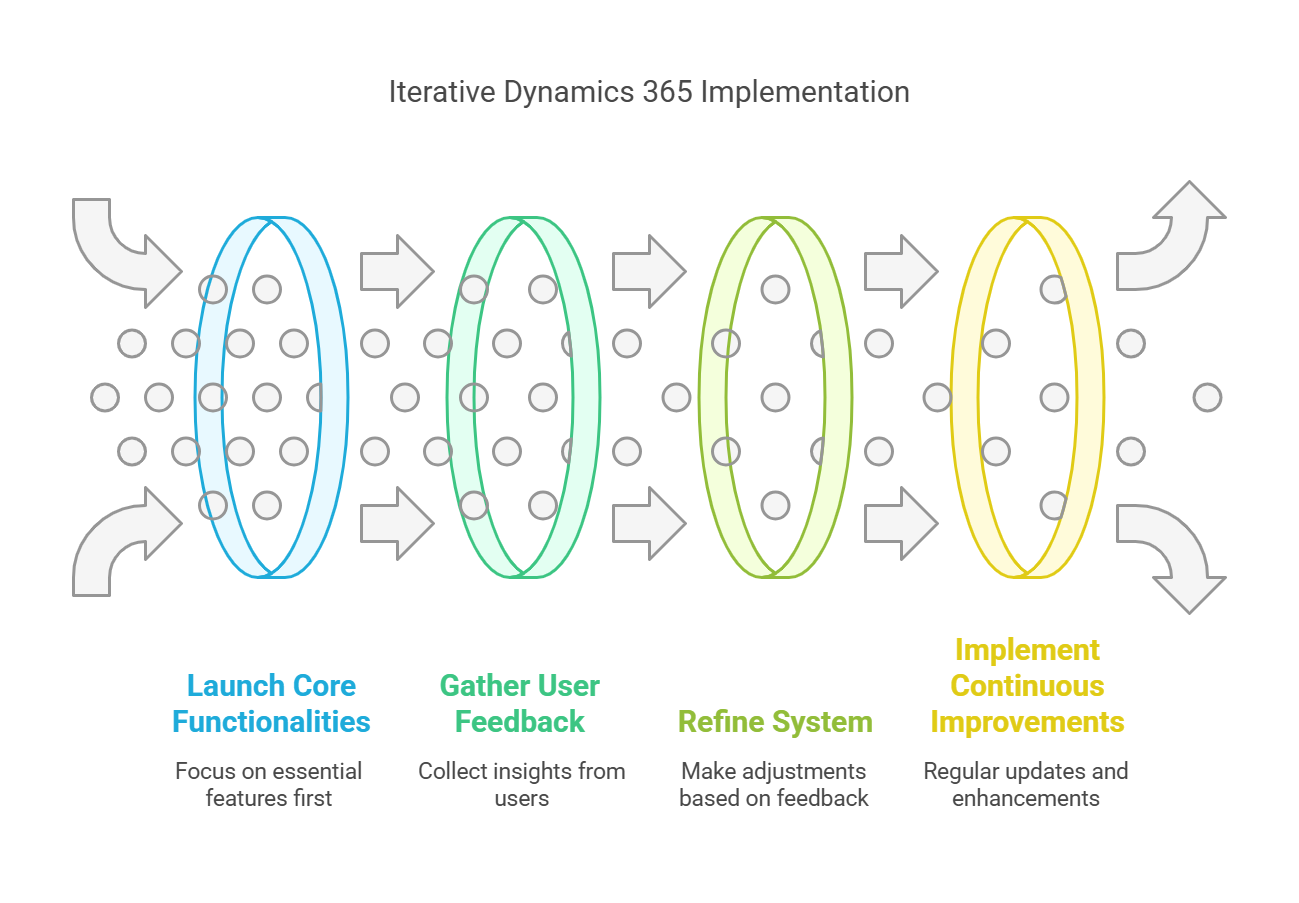
Launch What Matters First
Don’t try to build everything at once. Start with the core functionalities that solve your most pressing business needs. Get it in the hands of users early, listen to their feedback, and adjust as needed. For example, if sales teams struggle with lead tracking, prioritize rolling out the CRM's lead management first.
Refine as You Go
Every business evolves, and your CRM should too. Regular updates based on real user insights help keep the system relevant, user-friendly, and aligned with business goals. Companies that follow this approach have reported a 30% reduction in system errors and higher user trust.
Stay Future-Proof
Instead of ripping and replacing systems every few years, small, continuous refinements keep your investment working for the long haul. A global retailer using this approach cut adaptation time by 25% when responding to market changes.
2. Align Key Metrics to Business Outcomes, Not Just System Performance
Many organizations focus on system metrics like uptime, number of reports generated, or number of users logged in. However, these don’t necessarily indicate whether Dynamics 365 is delivering real business value. Instead, leading companies align their KPIs with business objectives such as revenue growth, customer satisfaction, and operational efficiency—seeing higher productivity and ROI compared to those focused purely on system performance.
Here's a detailed account that helps you understand the ways to define and track the right KPIs.
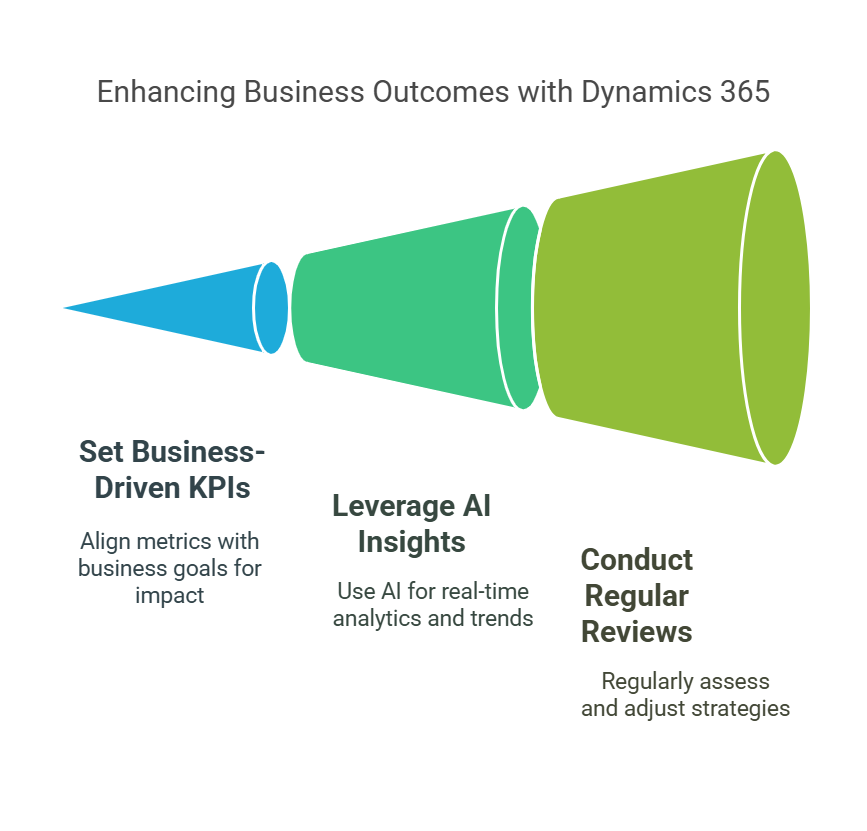
Set Business-Driven KPIs
Your KPIs should measure impact, not just activity. Instead of focusing on how many users log in, track how Dynamics 365 improves revenue, efficiency, and customer experience. Some key metrics include:
- Strong Revenue Growth → Measure sales conversion rates before and after implementation. Businesses that align CRM with sales processes have seen a 15% boost in performance, as seen in Heineken’s case study with AI-driven insights.
- Strong Process Efficiency → Track reductions in time spent on core processes like customer onboarding or order fulfillment. Companies that optimize workflows report up to a 25% productivity increase.
- Strong Customer Satisfaction → Use surveys, Net Promoter Scores (NPS), and support ticket data to evaluate whether customer service has improved post-implementation.
Leverage AI to Gain Deeper Insights
Microsoft Dynamics 365’s AI-driven analytics provide real-time performance tracking, helping businesses go beyond static reports. AI can:
- Monitor Performance in Real Time → Track how well users are adopting the system and where friction points exist.
- Identify Trends and Opportunities → AI can uncover patterns in customer behavior and operational inefficiencies that manual analysis might miss.
- Enhance Decision-Making → Heineken used AI-powered insights within Dynamics 365 to refine sales strategies, resulting in a 15% sales improvement.
Conduct Regular Reviews (30-60-90 Days)
Just like an iterative implementation approach, KPI tracking should be ongoing—not a one-time exercise. Set up structured reviews at 30, 60, and 90 days to:
- Assess Goals → Are the business objectives being met? If not, where are the gaps?
- Gather User Feedback → Are employees finding the system useful? Where are they facing friction?
- Make Adjustments → Adapt workflows, automate repetitive tasks, and refine training based on insights.
Microsoft’s own internal deployment of Dynamics 365 for global sales teams found that 90-day reviews improved efficiency by 20%, as they were able to make data-backed adjustments to sales strategies rather than relying on assumptions.
Get a detailed look at the Microsoft Dynamics 365 upgrade process with real-world case insights. Learn best practices, challenges, and strategies for a smooth transition.
3. Establish a “Fail Fast, Learn Faster” Mindset in Customization
One of the biggest pitfalls in Microsoft Dynamics 365 implementation is the tendency to over-customize. Instead of treating customization as a default solution, organizations should prioritize experimentation and adaptability—a "fail fast, learn faster" approach that minimizes unnecessary modifications while ensuring the system evolves with actual user needs.
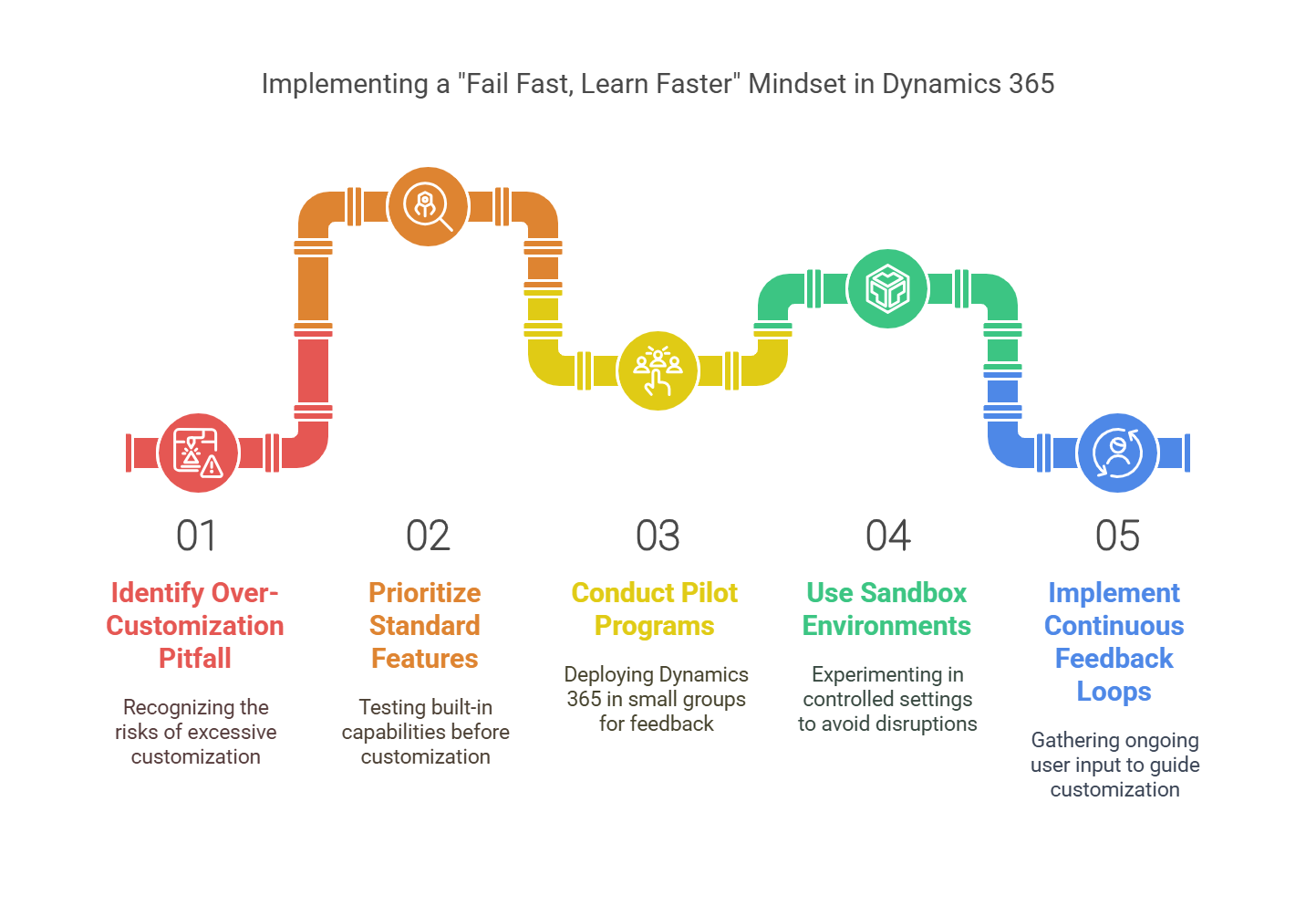
Test Standard Features First—Before Customizing
Many businesses rush into customization without fully exploring the built-in capabilities of Dynamics 365. Yet, Microsoft's out-of-the-box features are designed to accommodate common business processes without requiring extensive modifications.
How to do it:
- Leverage Built-in Capabilities → Conduct in-depth testing of standard features before requesting custom development. This ensures businesses don’t reinvent solutions that already exist.
- Run Pilot Programs → Deploy Dynamics 365 in pilot groups and gather real-world feedback to evaluate whether customizations are truly needed.
4. Treat Data as a Strategic Asset, Not Just a Migration Task
Migrating to Microsoft Dynamics 365 isn’t just about transferring data—it’s about ensuring it remains accurate, useful, and aligned with business needs. Without a structured approach, organizations risk carrying over outdated, duplicate, or incomplete data, leading to inefficiencies and compliance risks. Here’s how businesses are doing it right:
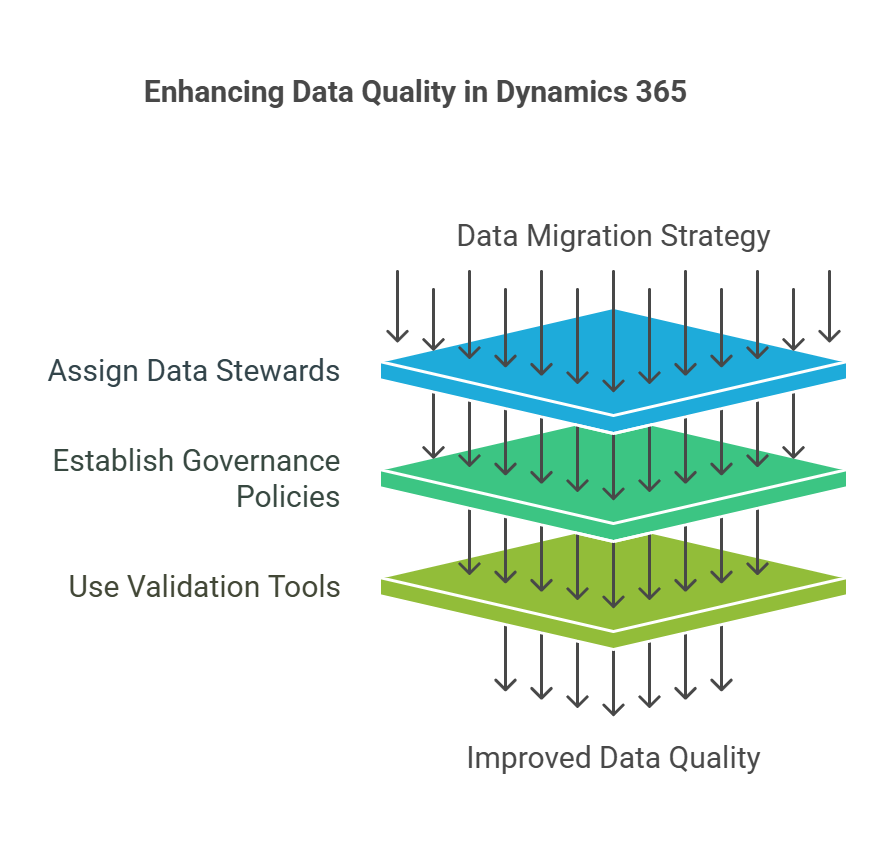
Assign Data Stewards for Continuous Oversight
Data quality needs dedicated attention. Without accountability, errors accumulate, making reporting unreliable and slowing operations.
- Designate data stewards to monitor accuracy, consistency, and governance before, during, and after migration.
- Implement ongoing monitoring with real-time validation checks to prevent issues from becoming long-term problems.
Establish Strong Data Governance from Day One
Unstructured data creates compliance risks and reduces decision-making effectiveness. Organizations that enforce governance policies early ensure data remains consistent, secure, and accessible.
- Define clear standards for data entry and management across teams to prevent inconsistencies.
- Ensure compliance by aligning policies with industry regulations like GDPR and HIPAA to protect sensitive information.
Automate Data Validation and Cleansing
Manual data cleanup is slow and prone to errors. Automated tools proactively flag duplicate, outdated records, and inconsistencies before they become a problem.
- Enable real-time validation to detect and correct errors as data is entered.
- Automate data cleansing and deduplication using AI-powered tools to eliminate redundant and incomplete records before migration.
Microsoft reduced data redundancy by 40 percent using automated validation tools in its own Dynamics 365 migrations, ensuring cleaner and more actionable data. By treating data migration as a strategic process rather than a one-time task, businesses improve efficiency, ensure compliance, and maximize the value of their CRM investment.
5. Design Role-Specific User Journeys Instead of Generic Training
Generic training programs often fail to prepare employees for real-world use of Microsoft Dynamics 365. Without context, users struggle to connect what they learn with their daily tasks, leading to slow adoption and underutilized features. A role-specific training approach ensures that learning aligns with job responsibilities, making it practical, engaging, and impactful.
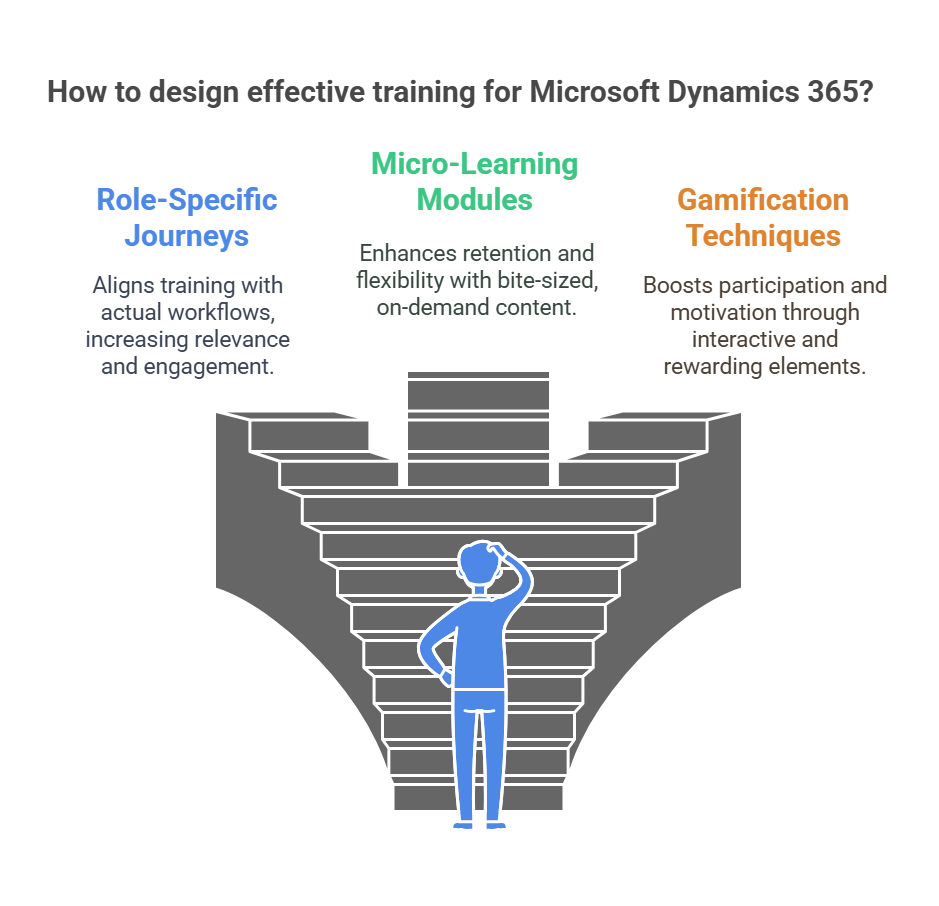
Training Should Reflect How Employees Work
For employees to use Dynamics 365 effectively, training must mirror their workflows. Too often, training covers broad system functionalities instead of addressing specific needs for sales teams, customer service reps, finance teams, and IT administrators.
- Personalized Learning Paths: Structure training by role, ensuring employees only focus on relevant features.
- Contextual Learning: Build training scenarios based on real business processes to help users see the value of the system in their daily work.
Microsoft’s sales teams saw a 50% increase in engagement when training was tailored to their job functions.
Break Training into Digestible Sessions
Lengthy, lecture-style training overwhelms employees and leads to low retention. Instead, organizations should implement micro-learning—short, focused training modules that employees can complete in small increments.
- Short & Focused Modules: Training should be structured in small, manageable lessons that employees can absorb quickly.
- On-Demand Learning: Provide access to self-paced training so employees can revisit key topics when needed.
Make Learning Engaging with Gamification
When employees are rewarded for progress, they are more likely to stay engaged. Gamification techniques like achievement badges, leaderboards, and interactive challenges can make learning fun and competitive.
- Recognition & Rewards: Use incentives like digital badges and certificates to motivate employees.
- Interactive Challenges: Encourage friendly competition through leaderboards and performance-based recognition.
6. Develop a Crisis-Resilient Change Management Strategy
User resistance is a common challenge when rolling out Dynamics 365. Without a clear change management strategy, businesses risk poor adoption, workflow disruptions, and project delays. A structured approach helps ease the transition and ensures users engage with the system effectively.
Identify Key Users to Guide the Transition
People are more likely to accept changes when they see others in their team using the system successfully. Having experienced employees lead the way can make adoption smoother.
- Select Experienced Users from Different Teams: Choose individuals who understand business processes well and can support their colleagues.
- Encourage Open Discussions: Let these users collect feedback, share common concerns, and help clarify system usage.
Track Employee Feedback and Adjust Approach
Understanding how employees feel about the new system helps businesses address concerns before they escalate.
- Use Simple Feedback Tools: Regular surveys or team meetings can highlight challenges users face.
- Modify Communication Based on Concerns: If employees struggle with certain features, adjust training or provide additional support.
Prepare Backup Plans for Unexpected Issues
No system rollout is perfect. Having a plan in place for potential roadblocks helps keep business operations running smoothly.
- Identify Risk Areas Early: Determine which processes might face the most challenges and prepare workarounds.
- Keep Business Running During the Transition: Ensure employees have temporary solutions if issues arise, so productivity isn’t affected.
7. Proactively Plan for System Scalability, Not Just Initial Requirements
A well-structured Dynamics 365 implementation should go beyond current needs, ensuring flexibility for future business growth. Without scalability and adaptability, businesses risk costly upgrades, data silos, and operational inefficiencies.

Here’s some tips to make it scalable:
Design a System That Can Adapt Without Disruptions
Many businesses lock themselves into rigid CRM structures that don’t scale as they grow. A modular approach prevents this by allowing incremental updates without redoing the entire system.
- Use a Modular Design: Avoid rigid configurations by designing components that can be expanded or modified as business needs evolve.
- Prioritize Configurability Over Customization: Over-customization makes upgrades difficult. Instead, use built-in Dynamics 365 capabilities that allow easy adjustments without requiring extensive redevelopment.
Ensure Seamless Integration with Other Business Systems
Businesses rarely rely on a single platform. An isolated CRM creates data silos, slows down decision-making, and forces employees to switch between disconnected tools.
- Plan for API-Based Integrations: Use cloud-native connectors to integrate Dynamics 365 with finance, supply chain, and customer service platforms.
- Enable Cross-Platform Workflows: Ensure sales, customer support, and finance teams work from a unified dataset rather than fragmented systems.
Build a Data Management Strategy for Global Growth
Expanding to new regions without a structured data approach can create compliance risks, slow down performance, and make reporting difficult.
- Align with Regional Regulations: Ensure the system adheres to GDPR, HIPAA, and other regional data laws from day one.
- Use Localized Data Centers: Storing data closer to users improves response times and ensures compliance with country-specific regulations.
- Standardize Data Governance Policies: Define clear rules on data access, security, and storage to prevent inconsistencies as the business expands.
8. Create a Post-Implementation Optimization Roadmap
Going live with a Dynamics 365 implementation is just the start. Without continuous monitoring and refinement, businesses can face performance slowdowns, rising storage costs, integration issues, and poor user adoption. A structured Dynamics 365 support strategy ensures efficiency, keeps costs in check, and maximizes long-term ROI.
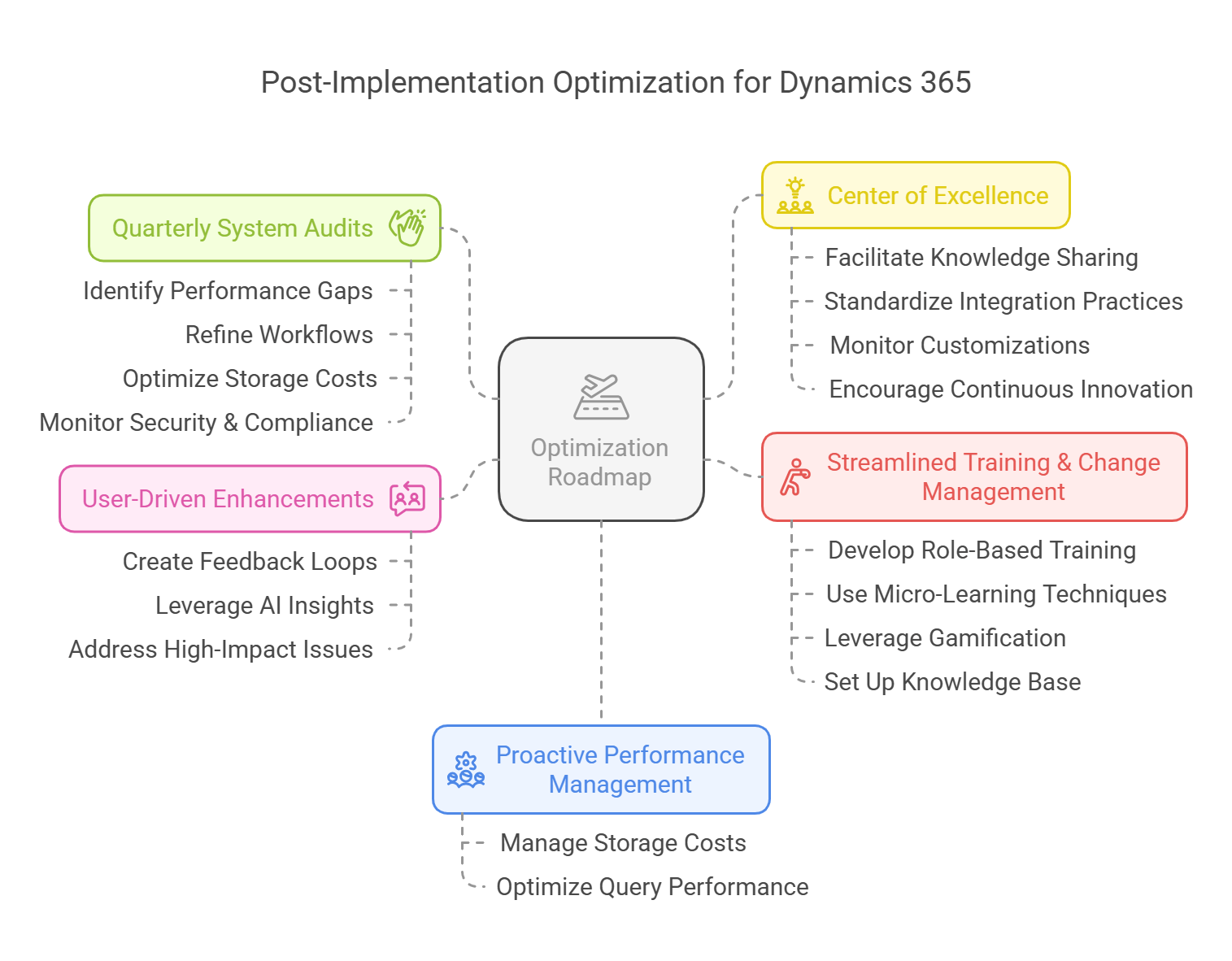
Regular System Audits for Performance and Cost Efficiency
Without periodic reviews, inefficiencies pile up, security risks increase, and storage costs spiral out of control.
- Identify Performance Bottlenecks: Use tools like Azure Synapse Link to analyze system slowdowns and optimize data processing.
- Optimize Storage Costs: Archive unnecessary data, implement retention policies, and use third-party tools like XRMToolBox.
- Ensure Security & Compliance: Regularly review audit logs and enforce security controls to meet regulatory standards.
User Feedback to Drive System Improvements
Employees interacting with Dynamics 365 daily can provide valuable insights into inefficiencies. Ignoring their feedback leads to poor adoption and underutilization of the CRM’s capabilities.
- Set Up a Feedback Loop: Create a structured way for users to report issues and request enhancements.
- Use AI for Usage Insights: Monitor user interactions with AI-driven analytics to identify common pain points.
- Prioritize Key Fixes: Focus on simplifying navigation, eliminating duplicate records, and improving integrations.
Establish a Governance Framework to Prevent System Overload
Without structured governance, customizations become excessive, security gaps widen, and inefficient workflows become deeply embedded. A governance framework ensures long-term system stability.
- Centralized Knowledge Sharing: Maintain best practices, troubleshooting guides, and Power BI dashboards for system monitoring.
- Control Customization Expansion: Use modular configurations and Dataverse APIs to avoid excessive technical complexity.
- Encourage Innovation: A dedicated team should explore new AI-driven features, automation improvements, and mobile capabilities.
Proactively Manage Performance and Storage Bottlenecks
Storage and system performance degrade over time, slowing down reporting, increasing costs, and frustrating users. Addressing these proactively keeps operations smooth.
- Reduce Storage Costs: Archive old records in Azure Blob Storage instead of consuming costly Dataverse capacity.
- Speed Up Reporting & Analytics: Use Azure Synapse Link to offload data processing and improve reporting performance.
- Optimize Queries: Regularly fine-tune database indexing and optimize Power BI reports to reduce system strain.
Improve Training and Change Management for Higher User Adoption
A poorly trained workforce leads to low adoption and reliance on manual processes, reducing the CRM’s value.
- Role-Based Training: Customize training modules for different teams instead of using generic sessions.
- Micro-Learning for Better Retention: Use short, interactive training modules instead of long, one-time workshops.
- Encourage Engagement with Gamification: Introduce leaderboards, rewards, and certification programs to drive adoption.
- Create a Self-Service Knowledge Base: Maintain FAQs, training videos, and troubleshooting guides to reduce IT support dependency.
Conclusion
With a dominant 87% market share in the ERP space and over 500,000 organizations relying on it—including many Fortune 500 companies—Microsoft Dynamics 365 has established itself as a leader in business transformation.
If you're planning to implement Dynamics 365, having the right strategy and expertise is crucial for success. With millions of users and a strong presence across industries, Dynamics 365 offers immense potential—but only with a well-executed implementation.
Our Microsoft Dynamics 365 implementation services help businesses navigate the process smoothly, from planning and customization to integration and user adoption. Get in touch with our experts today to ensure your transition is seamless and aligned with your business goals.
Recent Posts
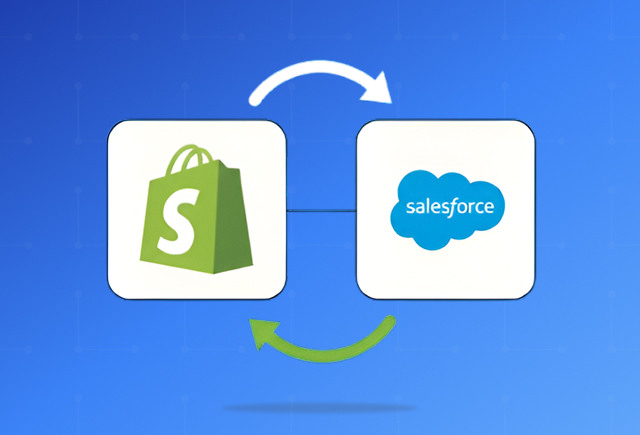
Salesforce Shopify Integration [A Complete Guide]
Dec 03, 2025
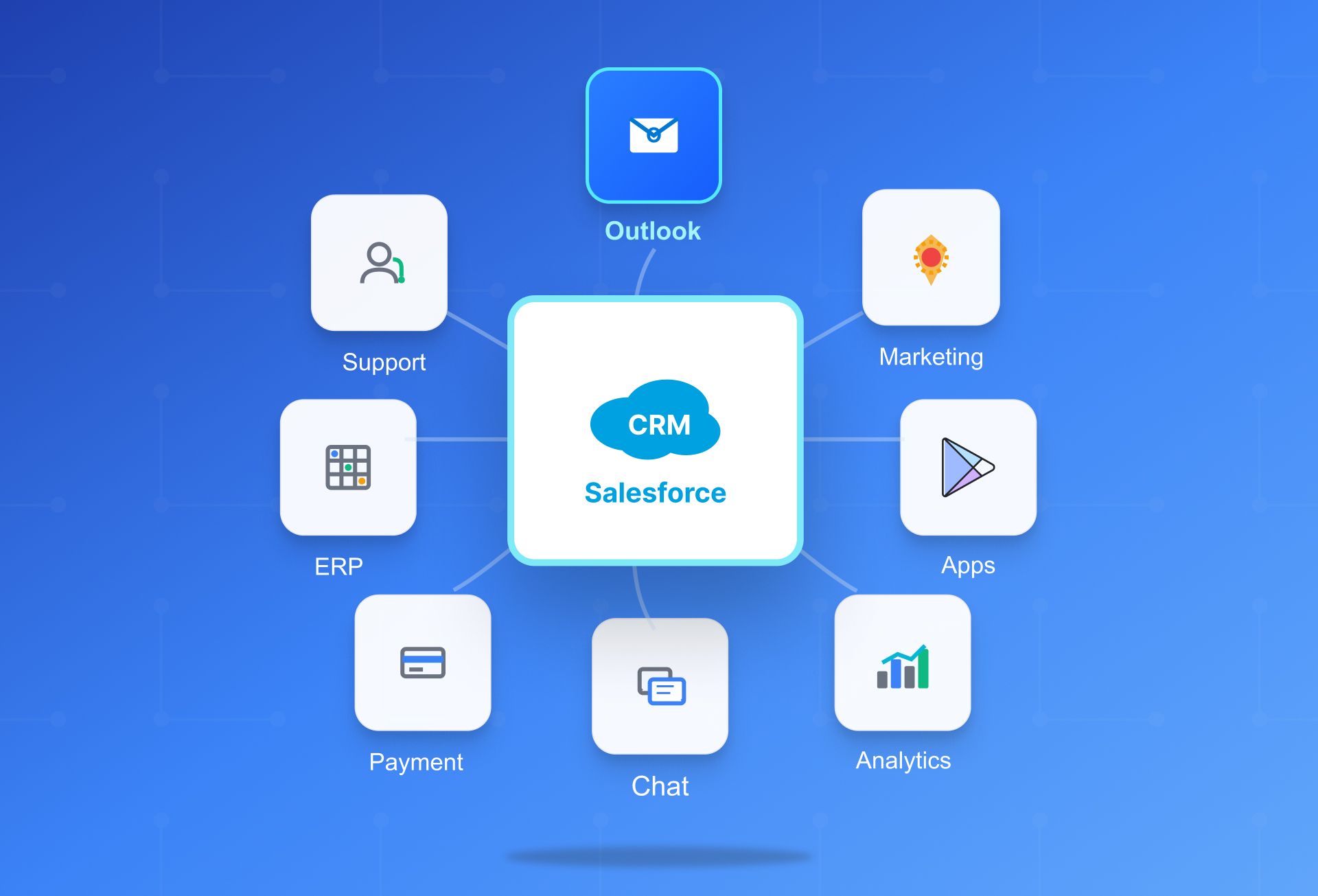
Salesforce Outlook Integration Guide
Oct 30, 2025
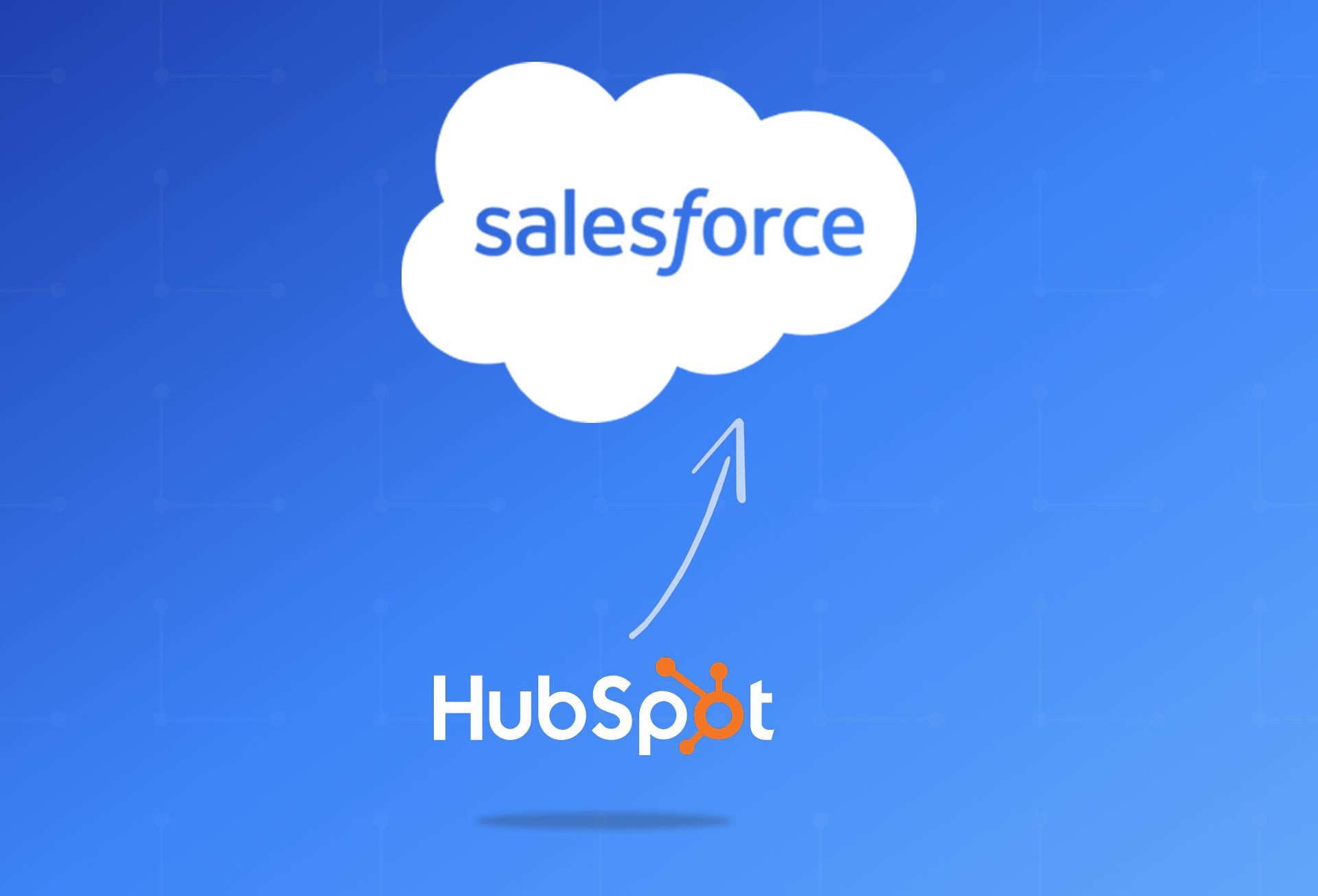
HubSpot Salesforce Integration Guide [All You Need to Know]
Oct 28, 2025
Category
Our Expertise
About Author

Aiswarya Madhu
Aiswarya Madhu is an experienced content writer with extensive expertise in Microsoft Dynamics 365 and related Microsoft technologies. With over four years of experience in the technology domain, she has developed a deep understanding of Dynamics 365 applications, licensing, integrations, and their role in driving digital transformation for organizations across industries.
Never Miss News
Want to implement Dynamics 365?
We have plans which will meet your needs, and if not we can tweak them around a bit too!


